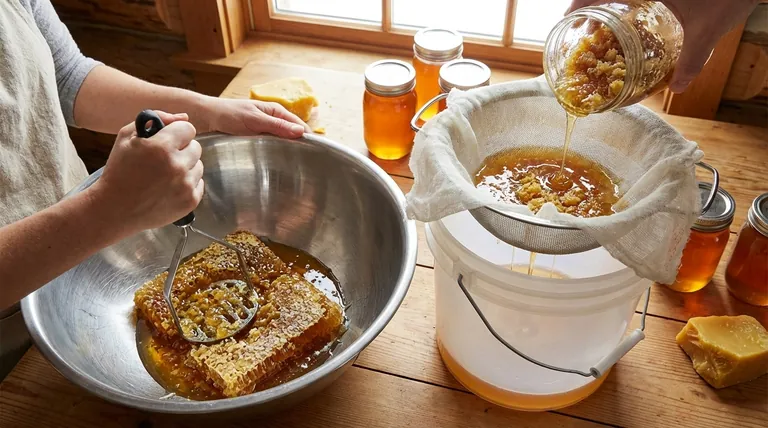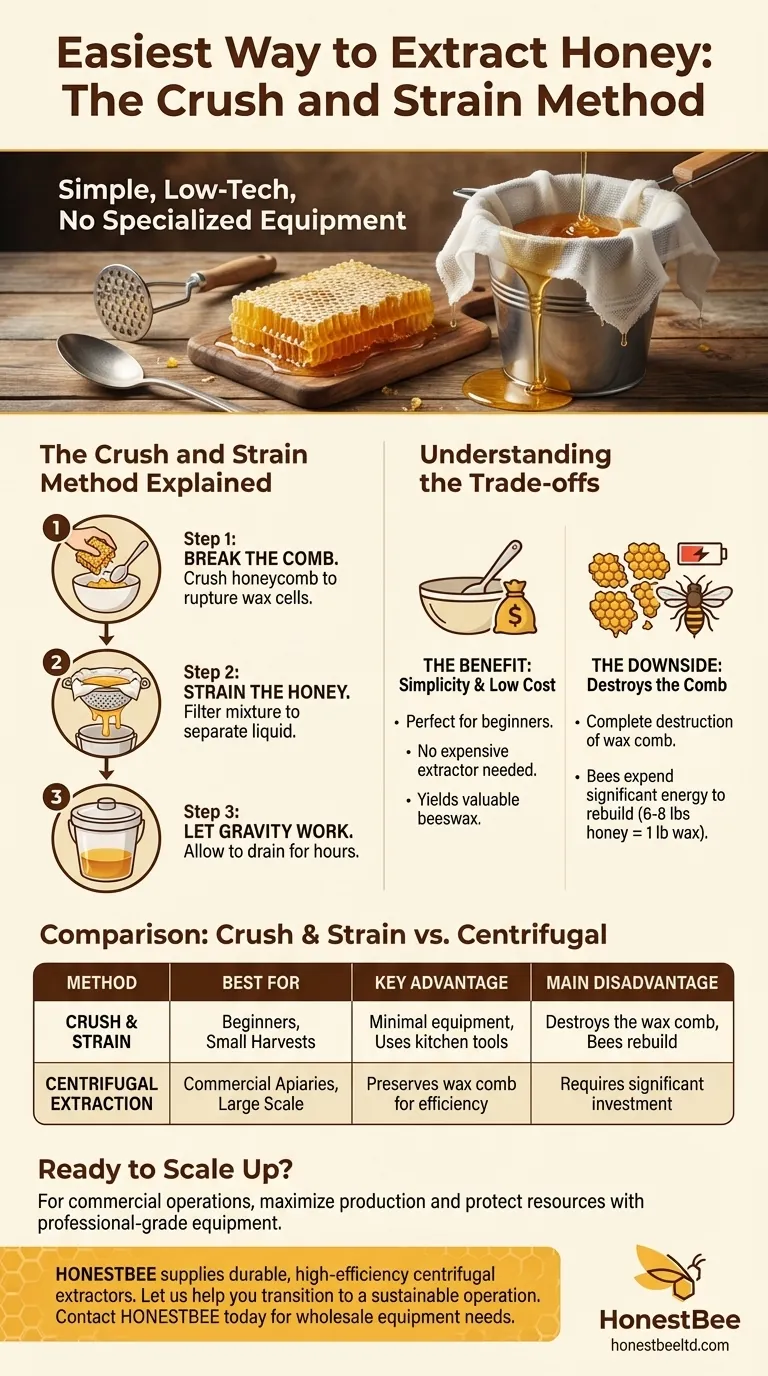By far, the easiest way to extract honey is the crush and strain method. This simple, low-tech process involves breaking up the entire honeycomb to release the honey and then filtering the mixture through a strainer or cloth to separate the liquid honey from the beeswax. It requires no specialized equipment beyond basic kitchen tools.
For the hobbyist or small-scale beekeeper, the choice of extraction method is a classic trade-off between simplicity and efficiency. While the crush and strain method is undeniably the easiest, it comes at the cost of destroying the wax comb, which forces the bees to expend significant energy to rebuild it.

The Crush and Strain Method Explained
This technique is the oldest and most straightforward way to harvest honey. It's particularly well-suited for beekeepers using top-bar hives or for anyone with a small number of frames who wants to avoid investing in expensive equipment.
Why It's the Simplest Approach
The primary advantage is the minimal need for specialized gear. You do not need a centrifugal extractor, an uncapping knife, or any other dedicated beekeeping tools. Common household items are sufficient.
This method works by physically breaking the wax cells rather than just removing their caps, bypassing the tedious step of uncapping each frame before extraction.
Step 1: Breaking the Comb
First, cut the honeycomb from its frame or top bar and place it into a large, food-grade bucket or bowl.
Using a clean tool like a potato masher, a large spoon, or even your clean hands, thoroughly crush the comb. The goal is to rupture every wax cell to ensure all the honey is released.
Step 2: Straining the Honey
Position a large strainer or a colander lined with several layers of cheesecloth over a second clean, food-grade bucket. A fine mesh cloth works very well for this.
Pour the entire mixture of crushed wax and honey into the strainer. The honey will begin to slowly drip through the filter into the collection bucket below.
Step 3: Letting Gravity Work
This process relies entirely on gravity. Cover the setup with a lid or cloth to prevent dust, debris, or insects from getting into your honey.
Allow the honey to drain for several hours or even overnight. The warmer the room, the faster the honey will flow. Once it's done, the wax can be collected from the cloth for rendering and other uses.
Understanding the Trade-offs
While simple, the crush and strain method is not without its significant disadvantages. It's crucial to understand what you are giving up for the sake of convenience.
The Major Downside: Destroying the Comb
The most significant trade-off is the complete destruction of the drawn-out wax comb. Bees expend a tremendous amount of energy and resources to build this intricate structure.
It is estimated that bees consume 6-8 pounds of honey to produce just one pound of wax. By destroying the comb, you force the colony to dedicate its future efforts to rebuilding rather than producing more honey.
The Clear Benefit: Simplicity and Low Cost
The appeal of this method is its accessibility. You can process your first honey harvest without spending hundreds of dollars on an extractor. This low barrier to entry makes it perfect for beginners.
Furthermore, this method yields a clean block of beeswax, which is a valuable product in its own right for making candles, balms, or polishes.
A Note on Other Methods
The industry standard is centrifugal extraction. This involves using a machine to spin frames at high speed, flinging the honey out while preserving the delicate wax comb. While far more efficient and better for the bees' productivity, it requires a significant financial investment.
Making the Right Choice for Your Goal
Your ideal extraction method depends entirely on your scale, hive type, and long-term beekeeping goals.
- If your primary focus is a simple first harvest from a top-bar hive: The crush and strain method is the most practical and cost-effective choice.
- If your primary focus is maximizing honey production over multiple seasons: Investing in a centrifugal extractor is essential to preserve the comb and save the bees' energy.
- If your primary focus is a small-scale harvest with minimal investment: Crush and strain provides both honey and usable beeswax with tools you likely already own.
Choosing the easiest method means prioritizing immediate simplicity over the long-term efficiency of your hive.
Summary Table:
| Method | Best For | Key Advantage | Main Disadvantage |
|---|---|---|---|
| Crush & Strain | Beginners, Top-Bar Hives, Small Harvests | Minimal equipment needed; uses common kitchen tools | Destroys the wax comb, forcing bees to rebuild |
| Centrifugal Extraction | Commercial Apiaries, Large-Scale Production | Preserves the wax comb for higher long-term efficiency | Requires significant investment in specialized equipment |
Ready to scale up your honey harvest?
For commercial apiaries and beekeeping equipment distributors, the crush and strain method is just the beginning. To maximize your honey production and protect your bees' resources, you need professional-grade equipment. HONESTBEE supplies durable, high-efficiency centrifugal extractors and other essential beekeeping supplies through our wholesale-focused operations.
Let us help you transition from simple methods to a more productive and sustainable operation. Contact HONESTBEE today to discuss your wholesale equipment needs and boost your honey yield.
Visual Guide

Related Products
- HONESTBEE 3-Frame Manual Acrylic Honey Extractor
- Stainless Steel 3 Frame Manual Honey Extractor Spinner for Bee Honey Extraction
- Plastic Hand Crank 2 Frame Honey Extractor Low Price
- 6 Frame Manual Stainless Steel Honey Extractor Beekeeping Equipment
- electric honey extractor honey centrifuge 3 frame honey extractor stainless steel honey frame extractor
People Also Ask
- What size honey extractor do I need? Match Frame Capacity to Your Hives for Maximum Efficiency
- What is a fun and easy alternative to using a honey extractor for harvesting honey? Try the Crush and Strain Method
- What machines are needed in beekeeping besides basic tools? Scale Your Honey Harvest Efficiently
- What is the most common method for cleaning a honey extractor? Protect Your Honey & Equipment
- How do you manually extract honey? Choose the Best Method for Your Hive



















